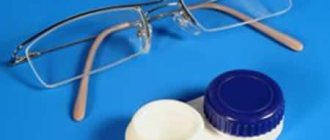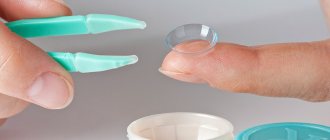Is it possible to wear lenses if you are farsighted?
With the help of contact lenses, even a high degree of hypermetropia (+6 D or more) can be corrected, so the answer to the question posed is completely obvious - it is possible. But the fact is that the selection of these optical devices must be taken with full responsibility, because wearing unsuitable lenses is fraught with a further decrease in near visual acuity, the development of asthenopia (rapid eye fatigue, the feeling of sand poured into them, headaches), as well as the occurrence of complications ( cataracts, glaucoma, inflammatory eye diseases).
Farsightedness refers to refractive errors and is expressed in the fact that light rays passing through the optical media of the eye are focused not on the surface of the retina, as provided by nature, but on a conventional plane behind, sometimes far beyond the boundaries of the eyeball. If the deviation from the norm is insignificant (within 3-5 diopters), it can be compensated by accommodation (change in the curvature of the lens). But with age, this mechanism is also depleted, and then the need arises for surgical, laser or optical vision correction.
Contact lenses for farsightedness have positive diopter values because they are designed to replace a worn lens or an insufficiently convex cornea, bringing the focus of light rays closer to the retina. This is possible due to the collecting optical design.
You need to understand that wearing contact lenses is not a method of treating farsightedness, age-related or congenital, but if you use these products correctly, you can relieve eye strain and slow down the wear of the visual apparatus. Modern SCLs (soft contact lenses) are very comfortable and safe, so they are allowed to be worn not only by adults, but even by children over 8 years old. In addition, there are special lenses for correcting myopia and farsightedness at the same time, which is especially important in the case of presbyopia (“senile vision”).
Video: how to choose the right lenses and whether they can replace glasses:
Advantages and disadvantages of contact lenses
Lenses are better than glasses, if only because they cope with their main task much better. They not only provide high clarity of vision, but also maintain a good lateral view without causing distortion or narrowing the field of view.
There are other obvious benefits of contact lenses for farsightedness:
- They do not need to be carried around in a case, wiped, taken off and put on throughout the day;
- They are very effective and can correct even severe hypermetropia;
- They can be considered comfortable and completely safe when used correctly, because the soft structure is not capable of injuring the eyes;
- They are absolutely invisible, do not spoil your appearance and can even improve it if you prefer a colored version;
- They can be left on during active sports, thereby maintaining clarity of vision even in extreme conditions;
- They do not glare or fog up, unlike glasses.
The disadvantages of SCL include the following points:
- Quite a long adaptation period. Moreover, some people, especially very young and elderly patients, refuse to wear contact lenses for farsightedness because they cannot get used to the sensation of a foreign body in the eye;
- The relatively high cost, combined with the need for frequent replacement, can make this type of optical vision correction simply inaccessible to some categories of citizens;
- The need for very careful adherence to the rules of hygiene, storage and care of products;
- The likelihood of developing complications (conjunctivitis, blepharitis, keratitis), especially if the above rules are neglected.
Contraindications to wearing contact lenses for farsightedness and any other vision defects are as follows:
- Infectious and inflammatory eye diseases;
- Pathologies of the lacrimal glands and disturbances in the composition of the tear fluid;
- “Dry eye” syndrome or vice versa, increased tearfulness;
- Bronchial asthma, allergies, vasomotor rhinitis;
- Injuries, functional and degenerative-dystrophic changes in the eyes (glaucoma, cataracts, dislocation and subluxation of the lens, severe strabismus, drooping or incomplete closure of the eyelids (lagophthalmos).
Video from the program “Live Healthy!” Glasses or contacts?
What types of contact lenses are there for farsightedness?
Many people are interested in what they need to pay attention to when selecting such products? After all, after undergoing an examination by an ophthalmologist, you will only know what refractive power in diopters they should have, as well as what lens design is best suited for correcting your specific visual impairment. But besides these aspects, there are others that directly affect the convenience, quality and cost of products. Let us consider the most important criteria for choosing an SCL in more detail.
Materials and characteristics
Currently, hydrogel and silicone hydrogel SCLs are the most widely used. The second option is preferable because it offers maximum safety and comfort. Several years ago, contact lenses made of water-gradient material appeared on the shelves of optical stores, which are superior to their old counterparts in all key parameters, but are much more expensive.
When choosing lenses for farsightedness, it is necessary to take into account such characteristics as oxygen permeability, water content, radius of curvature, tensile strength, optical power, design and purpose.
In addition to soft products, there are also hard contact lenses (RCLs). They are made from polymethyl methacrylate and organosilicon polymer, but are used extremely rarely - only about 10% of visual impairments are corrected using LCDs. We will talk about this in more detail below when we discuss night lenses and the orthokeratology technique.
Mode and duration of wearing
As for the service life of SCLs, based on this criterion they are all divided into four categories:
- One-day;
- Two weeks;
- One-month;
- Quarterly.
We emphasize that we are not talking about continuous wearing. Even a product intended for long-term use (3 months) is usually worn only during the day, and removed at night and stored in a special solution. In any case, after the expiration date, the lenses must be disposed of, since they lose their functionality and can even cause harm to the eyes.
The operation mode of MCL is as follows:
- Daytime – we described it above;
- Flexible – allows continuous stay in the same lenses for 2-3 days;
- Long-lasting – the product can be left in place for a whole week or more.
Even if the manufacturer assures that it is completely safe to wear their contact lenses for a long time, ophthalmologists still strongly recommend removing contact lenses at night and giving your eyes rest at least while you sleep.
Practice shows that people who regularly use products with prolonged use more often develop inflammatory complications, and sometimes even experience a rapid deterioration in visual acuity. Therefore, think, is it worth risking your health because of laziness? In any case, keep in mind that only silicone hydrogel SCLs, that is, products of the “latest generations,” are suitable for long-term wear.
Video: complications when wearing contact lenses:
Kinds
Contact lenses, depending on various parameters, are divided into the following types:
- Depending on the material: hydrogel and hydrogel-silicone, polymer lenses.
- Depending on the frequency of replacement: one-day, one-two weeks, 3 months, 6 months, annual.
- Depending on the mode and time of wear: daytime, prolonged, flexible, continuous.
- Depending on the level of transparency: transparent, colored.
- Depending on the type of design: multifocal and spherical.
Ophthalmologists do not divide lenses into small groups and distinguish two main types based on the type of material:
- Soft lenses;
- Hard lenses.
Soft lenses are made of hydrogel material, they bend easily, there is practically no discomfort while wearing them, they are easy to put on and take off.
More than 90% of ophthalmologists' patients wear soft lenses, because they are an excellent means of vision correction and have virtually no contraindications for use. This type of lenses is made on a hydrogel and silicone hydrogel base, which is why they must be stored in a special container with a solution.
As for hard lenses, they have a number of advantages over soft ones:
- Retains its shape for a long time;
- They wear for a long time;
- Significantly increase visual acuity;
- Provide a tight fit to the cornea of the eye.
Hard lenses are selected by an ophthalmologist; they are worn in case of serious vision problems and increase its quality.
They are ideal for vision correction in the presence of diseases such as astigmatism, orthokeratology, keratoconus. These lenses are made from polymer materials that provide a high degree of oxygen penetration to the cornea.
Proper lens storage
Rules for selecting contact lenses
If you are farsighted, only a qualified doctor can determine which lenses you need. He will also give practical advice regarding the type and mode of use of such products. Purchasing SCLs on your own without first consulting an ophthalmologist is almost certainly a waste of money, and sometimes the cause of complications.
To correctly select lenses for farsightedness, the following diagnostic procedures may be necessary:
- Visometry;
- Refractometry;
- Ophthalmoscopy;
- Accomodometry;
- Checking lateral vision and binocular functions of the eyes.
Here are the main criteria that need to be taken into account when choosing an SCL:
- Optical power
– this indicator is measured in diopters and characterizes the degree of hypermetropia in a particular patient;
- Radius of curvature
– the structure of the eyeballs may vary between people, but most patients are suitable for lenses with a standard radius of 8.6 mm;
- Water content
– the higher it is, the softer and more comfortable the product, however, harder specimens provide better clarity of vision;
- Oxygen permeability
– the risk of complications depends on it: “breathing” SCLs are safer in this regard;
- Tensile strength
– directly affects the service life of each individual pair of contact lenses.
How to use contact lenses?
Before putting the SCL on your eyes, you need to wash your face and hands with soap and water, then dry thoroughly. Any optics manufacturer must include an instruction manual with its product, which contains a schematic representation of the order of actions that you have to perform. Follow the prompts and in a few seconds the lenses will be in place.
In the evening, before going to bed, the SCL should be carefully removed, also based on the attached manual, and stored in a special solution. It has a standard composition and is sold in all major optical stores. However, it is worth clarifying which drug is best suited for your type of SCL. Both the solution and the plastic lens storage container itself must be replaced every 3-6 months.
If, while wearing contact lenses, you find signs of acute respiratory viral infection, flu, or bacterial infection of the upper respiratory tract, immediately remove the contact lenses and do not resume using them until you have completely recovered!
Otherwise, you will very easily get an infection in your eyes. It is unnecessary to talk about the need to contact an ophthalmologist in case of existing symptoms of eye inflammation - this goes without saying. In addition, you should be alert to any manifestations of discomfort directly or indirectly associated with MCL, ranging from lacrimation to headaches. Perhaps the lenses do not suit you or no longer suit you. An urgent visit to an ophthalmologist is required by situations such as sudden progressive deterioration of vision, pain and swelling in the eyeballs, and a sharp worsening of asthenopic syndrome.
Tips for care and selection
The correct choice of contact lenses ensures maximum wearing comfort, improves the quality of vision without harmful results, and careful and timely care minimizes the possibility of infectious diseases.
The main care tips are:
- Do not wear lenses more than 14 hours a day;
- Always change physical solution in the container before putting the lenses there;
- Monitor expiration dates;
- Put them on carefully so as not to injure your eyes or damage the lens itself.
You also need to know how to choose lenses correctly, here are some basic tips on how to choose them correctly:
- Consult an ophthalmologist;
- Determine the extent of your vision problems;
- Pay attention to the characteristics and parameters of the lenses;
- Choose lenses that best suit your indications;
- Buy lenses only at specialized outlets or pharmacies;
- Do not order contact lenses from an online store; you should immediately see what you are buying.
- When choosing lenses, pay attention to the fact that they are carefully packaged, so that they show no signs of mechanical damage, and that the expiration date and production date are indicated on the packaging;
- Always ask if there are any special precautions when using the lenses.
Eye drops when wearing contact lenses can be considered a necessary element for people who use long-term or extended wear.
What are night correction lenses and how to use them, read this article.
Episcleritis: symptoms and treatment:
Lenses for age-related farsightedness
Elderly people are most concerned about the question: are there lenses to correct presbyopia and related visual impairments, and what is better - to purchase suitable glasses for a long time or regularly spend money on purchasing SCLs?
As for the functionality of modern contact lenses, they are in no way inferior to glasses, and in some aspects even surpass them. For example, if we are talking about astigmatism against the background of hypermetropia. SCLs also cope well with such a common diagnosis among pensioners as myopia and farsightedness at the same time. Let's look at how they do this.
So, presbyopia is corrected using the following types of contact lenses:
Bifocal.
Otherwise called variables. These are the simplest of all SCLs designed to correct age-related vision pathologies. Such lenses have two optical zones: the upper one for distance and the lower one for near. The disadvantages of bifocal SCLs include too sharp a transition, the lack of a segment for clear visualization of mid-distance objects, and a narrowing of the field of view. This is why many older people cannot get used to wearing such devices.
Multifocal.
This is an improved version of previous SCLs. In addition to the optical zones for near and far vision, there is a third, “middle” zone located between them. Adaptation to such products is usually easier, but it is also not always possible to clearly see objects on the side - instead of squinting, you have to turn your head in the right direction. The disadvantages of multifocal SCLs, of course, also include their high cost.
Spherical.
Such contact lenses are used to correct age-related farsightedness using the monovision method. The doctor determines which eye of the patient has better near vision and which has better distance vision. Then a lens is selected for each eye that can provide respectively clear near and far vision. When the human nervous system adapts to different SCLs, the brain will choose which eye to look in a given situation. The downside is that products of this type are not suitable for drivers, since they cannot guarantee full binocular vision.
Aspherical.
Otherwise called progressive. They are made strictly individually, to order. The central optical zone of these lenses allows you to see well up close, and the peripheral zone allows you to see well at a distance. Moreover, the transition between them is smooth. This design takes into account the natural mechanism of constriction and dilation of the pupil. After all, when we look at nearby objects, our pupil narrows, and when we look into the distance, it expands. Aspherical MCLs are the most advanced and are capable of providing even high-quality lateral visibility. The only disadvantages are the high price and a rather long period of adaptation.
Concentric.
Otherwise called circular and, in fact, are a modification of bifocal SCLs, with the only difference being that the optical zones for near and far vision are concentric circles alternating 4-5 times. In this case, in the center of one lens there is an area “for near”, and in the center so that, as in the case of spherical SCLs, the brain itself chooses the “dominant” eye depending on the situation. Such products are not easy to get used to, and they are also not suitable for driving.
Myopia and farsightedness: what is the difference?
Myopia and farsightedness are refractive errors in the eye. In other words, in this case, the light ray is not refracted properly on the retina of the eye. A comparative description of these two phenomena requires a more detailed consideration.
Definition
With nearsightedness, or myopia, due to improper refraction of light rays, the image is projected in front of the retina. A characteristic feature of this phenomenon is the ability to see objects close up clearly, but distant objects blurry.
With farsightedness, or hypermetropia, on the contrary, the projection of the image in the eye occurs behind the retina. At the same time, distant objects are distinguished well, but near everything seems fuzzy and blurry.
Material on the topic: Farsightedness in children: developmental features
Note: as a rule, people with presbyopia, that is, age-related farsightedness, have the ability to see objects well in the distance. Otherwise, the patient may be equally poor at distinguishing objects from both far and near distances.
In everyday life, such phenomena are often defined by the term “minus” or “plus.” If myopia is meant, then the concept minus is used. When talking about farsightedness, the term plus is used.
Diagnostics
If vision problems occur, a correct diagnosis should be carried out by an ophthalmologist. The following methods are used to detect myopia and farsightedness:
- the use of special tables to determine the distance required for the patient to distinguish between symbols - most often, ophthalmologists use the Sivtsev table; for children who cannot read, the Orlova table is used;
- determining the light refractive ability of the eye using a special device - a refractometer, this procedure is called refractometry;
- determining the type of refraction of the eye using a skiascope, which is a mirror with one side flat and the other convex - this method is called “shadow test”, or skiascopy;
- Selection of trial lenses to determine the degree of visual impairment.
Lens selection
There are three degrees of development of myopia, as well as three degrees of farsightedness. The classification in this case is as follows.
Degrees of myopia:
- weak: up to -3 D;
- medium: -3 to -6 D;
- high: from -6 D.
Degrees of hypermetropia:
- weak: up to +3 D;
- medium: from +3 to +6 D;
- high: from +6 D.
Corrective lenses are selected depending on the extent to which vision is impaired. Moreover, for myopia and farsightedness they differ both in shape and appearance. This is typical for both glasses and contact lenses.
For myopia, biconcave lenses with negative optical power are used. Such lenses are called diverging and are designated in ophthalmology with a minus sign.
For hypermetropia, biconvex lenses with positive optical power are used. They are called collecting and are marked in ophthalmological practice with a plus sign.
Lens types
Note: if you wear glasses for myopia, then when looking through the glass, objects will visually shrink, but if you wear glasses for farsightedness, they will increase in size.
To correct vision for myopia or hyperopia, spherical contact lenses are used, and for presbyopia (age-related farsightedness) - multifocal, including bifocal.
Comparison of myopia and hypermetropia
In a nearsighted person, the distance from the retina to the top of the cornea (the so-called internal axis) may be increased in the eye. Another possibility is that the cornea is too steeply curved, which results in a short focal length in the eye. As practice shows, both of these phenomena are often combined.
The normal length of the human eye is 23-24 mm. With myopia it can reach 30 mm.
Important! An enlarged ocular axis is fraught with the development of complications such as retinal detachment or retinal rupture. This is due to the fact that in this case the retina is in a constantly tense position.
In a farsighted person, on the contrary, the ocular axis is too short. The cornea may also be too flat. The length of the eye in this case is less than 23 mm. As a rule, the deviation from the norm is no more than 2 mm.
Important! Due to this structure of the eye, hypermetropia increases the risk of glaucoma. Due to the shortened axis, the iris and lens move forward, which ultimately provokes an increase in intraocular pressure.
With any refractive error of the eye, people complain of the same symptoms - rapid fatigue of the visual organs, excessive strain, which can provoke headaches. There is often a burning sensation in the eyes. All this leads to a general decline in living standards. Therefore, treatment must be correct and started in a timely manner to prevent deterioration of the condition and the development of complications.
Toric lenses for farsightedness and astigmatism
Astigmatism
- a very complex refractive error, which is characterized by the presence of several focusing points of refracted light rays on the retina or even a focus in the form of a line, figure eight, or irregular figure. Often this pathology is combined with other defects, including hypermetropia. So, there are lenses for farsightedness that can correct astigmatism at the same time, and they work better than glasses, because they are adjacent directly to the cornea, while the glasses of glasses are removed from the eyeballs by about 12 millimeters, and this distance has a bad effect on efficiency of optical correction.
Such devices are called toric contact lenses (TCLs), are made from the same modern materials as conventional SCLs, and have the same advantages: convenience, safety, clarity of visualization. They can also be either transparent or colored. Only the design differs - the TCL is spherocylindrical in shape, that is, one lens has two optical powers at the same time. The first value is responsible for correcting astigmatism along the desired meridian, and the second is for correcting the accompanying pathology of refraction, in this case, farsightedness.
The selection of toric contact lenses requires an in-depth examination by an ophthalmologist. Wearing such products is indicated for astigmatism of 0.75 diopters and above.
Types of colored lenses
Traditionally, colored lenses are usually divided into opaque and translucent tinted ones, which make the eye color brighter. Recently, however, several more species have appeared.
- Opaque lenses
. Dense and intense, they are suitable for eyes of any color, including dark ones. When wearing them, the pupil area remains transparent because the dyes absorb light, which ensures the preservation of normal vision. The greatest naturalness is achieved when drawing the iris of the eye on a colored lens - a dark rim, color tints. This allows you to make your eyes more expressive and beautiful. In addition, compared to tint - translucent ones, such lenses can be worn by both light- and dark-eyed people. - Tinted lenses
. They are distinguished by a weak color, the main goal is to increase the brightness of the eyes. When worn, green eyes will turn turquoise and blue eyes will turn blue. There is no coloring on the peripheral part of the lens, which reduces the visibility of its edges against the background of the sclera. Therefore, the diameter of the tinted area is slightly smaller than the lens itself. Only suitable for light eyes. - Decorative lenses
. Initially they were intended for theatrical performances, but later lovers of extravagance and bright images caught their eye. Basically these are beautiful patterns that make the look brighter and more interesting. - Carnival lenses
. We can say that this is a type of decorative, but in this case more shocking patterns are used. You can, for example, come across such designs as “cat’s eyes”, or the eyes of a zombie, vampire, or alien. Particularly popular are lenses with black or red colored irises. There are also lenses with a spider web, smiley, flame, checkerboard, spiral, or even flower design. - Cosmetic lenses
. These lenses are designed to hide iris defects. They help with the presence of a cataract (when some part of the cornea of the eye is cloudy or white), the absence of the iris (aniridia), a difference in the size of the pupils (anisocoria), or the absence of a lens (aphakia).











